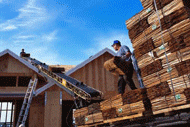How To Tell If You Need a New Roof
There's nothing more frustrating than a leaky roof! Dashing around with mops and buckets during a rainstorm could put a damper on any occasion; seeking out the source of the leak(s) can be even more exasperating. (Since water runs downhill, leaks are seldom straightforward. It's actually quite rare-even on flat roofs-for leaks to stem from a source directly overhead.)
Most roofs-even those made of metal-will eventually wear out. The smartest option is to maintain your roof with regular repairs and, when the time comes, to replace your roof before problems absolutely force you to do so. (This ounce of prevention is, indeed, worth the effort. Remember, your roof protects everything in your home from the outside elements; even a small leak can become a costly proposition when furnishings and belongings must be replaced.)
Since our home's roof is "over our heads" and is also something that we see on a regular basis, it is easy to miss signs of deterioration. An annual inspection will probably identify most roof problems. To do this, you need to view your roof from several vantage points.
First, stand at a distance from your roofline so that you can see the entire structure. This will reveal any obvious problems and give you an overall view of the situation. Pay special attention to the ridge and rakes, since this is where roofing material detaches from first. Then you can get up close and personal with the construction and further assess the damage.
When Inspecting your roof for damage, look for:
- Loose or popped nails
- Loose or missing flashing around vent pipes, chimneys or wall junctions
- Cracks or gaps in caulked areas
- Holes in the valleys
- Rotting (To assess this, test the pliability of material at the
eaves using a putty knife. You should be able to push in
a screwdriver's tip no more than one-half inch.
Finally, you should inspect your roof from the inside. To do this, enter your attic and inspect the underside of the structure. (You should do this even if you have not witnessed leaks in your living quarters; there could easily be undetected leaks in the attic that will cause problems down the road.) Look for the obvious signs of water damage: stains, matted or crusted insulation, etc.
Even if your inspection (or, if the leak found you instead of vice versa, your interior downpour) reveals leak problems, it does not necessarily mean that obtaining a new roof is imminent. The age of the roof and the signs of deterioration ultimately determine if repairs are a viable option or if you will require complete roof replacement.
The signs of deterioration on any type of roof system can be attributed to a combination of abuse from the sun's ultraviolet rays, storms, insects and temperature change adjustments. (Ultraviolet rays are probably most damaging, so it is quite common for one area of your roof-that which receives the most intense sun for longest length of time each day-to suffer more severe deterioration than others.) Damage caused by termites, hail, wind, rotting or settling of the house structure or chimney is frequently hidden from view.
FACTORS THAT CANWREAK HAVOC ON YOUR ROOF |
| SUN |
Heat and ultraviolet rays cause roofing materials to deteriorate over time. |
| RAIN |
When underneath roofing, water can work its way to the deck and begin to cause rot. |
| WIND |
High winds can lift the roof edges and force water underneath. |
| CONDENSATION |
The buildup of relatively warm, moisture-laden air in a poorly ventilated attic promotes decay of the wood sheathing and rafters. |
| MOSS & ALGAE |
Moss can grow on wood shingles and shakes if they are kept moist by poor sunlight conditions or bad drainage. Algae also grows in damp, shaded areas on wood. |
| TREES & BRANCHES |
Trees and branches should be trimmed away from the house to eliminate damp, shaded areas, and gutters should be kept clean to ensure good drainage. |
| MISSING OR TORN SHINGLES |
No longer offer your roof complete protection; there are missing "links in the armor" that shields your home from the elements. |
| SHINGLE DETERIORATION |
When shingles get old and worn out, they curl, split, and lose their waterproofing effectiveness and are more easily blown off, torn, or lifted by wind gusts.
|
| FLASHING DETERIORATION |
Many apparent roof leaks really are flashing leaks around chimneys, vents, skylights and wall/roof junctions. |
Home | Quote | Resources | Sitemap | About Us
© 2003-
, Roofing-Shingles-Contractor.com, All rights reserved. Privacy Policy

Web Site Exchange
|

Affiliate Partnership
|
|




